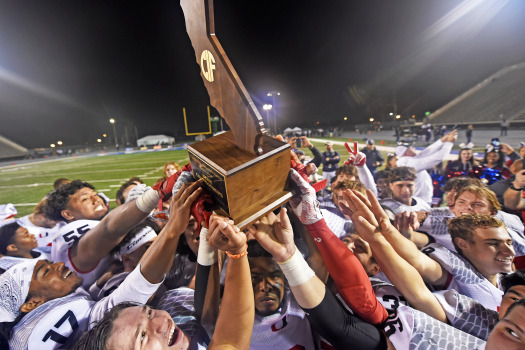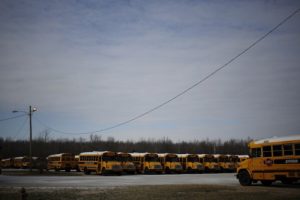NORWALK, CA – DECEMBER 13: Clayton Valley Charter’s Dillon Leao (3), center, holds the first place trophy with his teammates after defeating Aquinas during the 2019 CIF State Football Championship Division 2-AA Bowl Game at Cerritos College in Norwalk, Calif., on Friday, Dec. 13, 2019. Clayton Valley Charter defeated Aquinas 10-7. (Jose Carlos Fajardo/Bay Area News Group)
As thousands of high school football players in California languish with little hope for a spring season in many parts of the state, their counterparts further up the West Coast this week got the green light to start play in short order, with football practices set to begin in most of Western Washington in the final week of February.
Meanwhile, in California, high school athletics officials and advocacy groups are meeting almost daily with Gov. Gavin Newsom’s office and staff at the California Department of Public Health.
But, as leagues around the state refuse to budge the mandated April 17 end date for football, this week could prove decisive in their fight for a spring season. If football isn’t moved out of the orange tier — or sports detached from the tiered system entirely, as a collection of coaches and parents are calling for — few schools would be eligible to field a team in time for there to be even an abridged season.
That will be one ask of the Golden State High School Football Coaches Community, led in the Bay Area by Serra’s Patrick Walsh and De La Salle’s Justin Alumbaugh and in Southern California by Ron Gladnick of Torrey Pines, when they meet with Health and Human Services Secretary Dr. Mark Ghaly on Thursday afternoon.
That will follow a meeting between California Interscholastic Federation executive director Ron Nocetti and CDPH officials, as well as a “really good” meeting Tuesday between the coaches and the Governor’s office. Earlier this week, the National Federation of High Schools also updated its guidance to recommend to no longer separate sports by tiers.
Newsom on Wednesday was sympathetic to the cause and said he was hopeful they would be able to come to a compromise to play football this spring.
“We have been in very direct conversations … My team has been in constant contact trying to work through these different tiers “I’ll be honest with you, a lot of this is driven by football and folks wanting to get a football season in. I’m deeply sensitive to that,” Newsom said Wednesday during a news conference outside the Oakland Coliseum. “… We want to see this happen. We want to do it safely, and a lot of great data has been provided by the same groups that are suing us. … I’m very hopeful — I really mean this — I’m very, very hopeful that we can find a compromise here. I believe that’s possible as long as these case rates continue to move in the direction we’re moving.”
Currently, only three sparsely populated counties in Northern California are eligible to play high school football, meaning an adjusted case rate of fewer than four cases of COVID-19 per 100,000 residents per day. Los Angeles County, the most populous in the state, has never advanced to the orange tier since the system was introduced last fall. If teams aren’t allowed to play by the beginning of March, it’s unlikely there would be time for a season.
California is one of a handful of states where prep football hasn’t been played since 2019, and three of those have already canceled plans for a delayed spring season. In Maine, Hawaii and Connecticut, spring football seasons have been nixed entirely after the regularly scheduled fall season was postponed.
Football players in Massachusetts also just got the go-ahead for a condensed spring season. Nearby, in Oregon and Nevada, student-athletes remain in the same limbo as those in California.
Here’s a brief overview of where things stand in other western states, and why high school football has or hasn’t returned there.
Washington
Fall season? No
Spring season? Begins Feb. 22 in parts of the state; approved under Phase 2 of “Roadmap to Recovery.”
If California’s reopening system mirrored Washington’s, much of the Bay Area, if not the entire state, would be eligible to play most high school sports (and open indoor dining at limited capacity). The Puget Sound region, which is home to Seattle and its suburbs, became one of the first places on the entire West Coast to give football the green light when it met three of four determinative metrics: a positivity rate below 10%, ICUs below 90% capacity and decreasing trends of cases and hospital admissions over 14 days.
For context, the Bay Area currently reports 18.2% ICU capacity and none of its five core counties have positivity rates above 5.2%; in the wider region, as defined under the stay-at-home order, only Monterey County’s positivity rate exceeds 10%. The region’s cases are down 50% from two weeks ago (though still four times higher than the 7/100K threshold to exit the purple tier) and hospitalizations have declined by 27%.
Oregon
Fall season? No
Spring season? Not yet approved; cross country and soccer start Feb. 22, but while football and volleyball seasons are scheduled by the statewide athletic governing body, they remain sidelined by the state’s public health department.
Similar to California, different sports are permitted by an individual county’s COVID-19 risk level. In Oregon, however, sports defined as “full contact” — which includes football, basketball, wrestling, water polo, boy’s lacrosse, cheer and dance — are prohibited entirely, even in low-risk counties.
Flag football is defined as a “minimal and medium-contact” sport, meaning some teams have been allowed to hold 7-on-7 competitions. Other minimal contact sports include softball, baseball, soccer, volleyball and girls’ lacrosse. “No-contact” sports are defined as tennis, swimming, cross-country and track.
Nevada
Fall season? No
Spring season? Not yet approved; some winter sports have begun and other fall sports are scheduled to begin truncated seasons on Feb. 20, but football remains prohibited by Gov. Steve Sisolak.
Just south of Las Vegas, some sanctioned flag football games began in January. But otherwise, the winter sports season was heavily diminished with basketball and wrestling both canceled. Similar to Oregon, all “full-contact” sports remain banned in Nevada, but “minimal-contact” and “no-contact” sports can begin in counties deemed “low” or “moderate” risk for COVID-19.
That means while football remains sidelined, cross country, girls’ golf, volleyball, soccer and tennis are set to begin play Feb. 20.
Arizona
Fall season? Ended Dec. 12
Spring season? N/A
In Arizona, the fall high school sports season continued on as normal, despite some of the highest rates of COVID-19 in the nation. For many California athletes, it has been a refuge to continue refining their skills while skirting their home state’s restrictions.
Last month, the state’s athletic governing body initially voted to postpone the regularly scheduled spring sports season but a week later reversed its decision. Basketball, soccer and wrestling are all currently being played, with participants required to wear masks at all times.



















